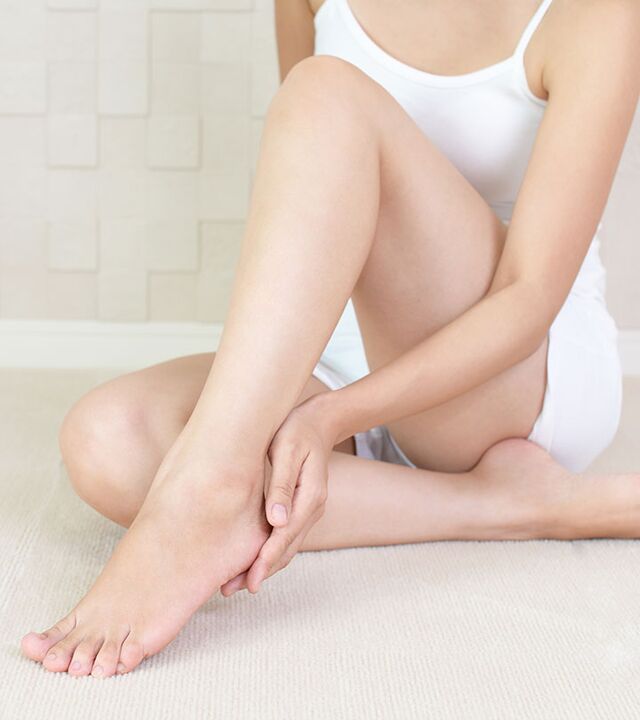
Currently, approximately 25% of the world's inhabitants suffer from mycoses. Often the disease is expressed in the legs. Big toe nail fungus gives many unpleasant moments, depriving a person of a normal and peaceful life. Also, it can spread to neighboring areas. How to cure a fungus on the big toe? Which medications are most effective? The answers to these questions are in our article.
appearance reasons
A fungus on the skin of the big toe can be caught in public places (baths, saunas, swimming pools, water parks and other institutions where people walk without shoes). It should be noted that fungal spores often get on people's skin, but not everyone gets infected. For the infection to occur, the microorganism must enter the skin cells, establish itself there and begin to multiply. This is facilitated by wounds and microcracks. We may not see them, but for the fungus they are wide open doors.

It is also possible to become infected if one of your family members is already sick with ringworm. This is observed if people do not follow the rules of personal hygiene, use a common towel, sleep in the same bed, have common shoes and socks.
The threat of a fungus infection in public places is reduced if a person has a strong immune system.
Thumbnail ringworm can also appear after trying on shoes in stores or at the market if you do it barefoot.
Other factors that contribute to fungal infection:
- Lack of foot hygiene.
- Excessive sweating (sweat is an excellent breeding ground for fungus).
- Flat foot.
- Wearing tight shoes.
- Old age (over the years, blood circulation is disturbed in people, immunity weakens).
- Perform a pedicure with instruments that have not been disinfected.
More often, the fungus appears first on the skin of the thumb, as it is easier to develop in the soft layers of the dermis. If the disease is not treated, it goes to the nails. However, in some cases, onychomycosis is the primary disease, and already from the affected nail plate, microorganisms spread to the skin.
signals
Microorganisms that infect the nail plate secrete enzymes that contribute to its destruction. Thus, the fungus prepares space for its own reproduction and colony growth. Symptoms depend on the stage of the disease.
Ringworm of the skin manifests itself in intense itching. This is the first sign. Then a blister appears, filled with light exudate. The blister bursts and a deep crack forms in its place. It is extremely painful, it even hurts a person to walk in shoes. In addition, the wound continues to itch. Dry, scaly skin forms around it. The crack may heal, but it soon reappears.
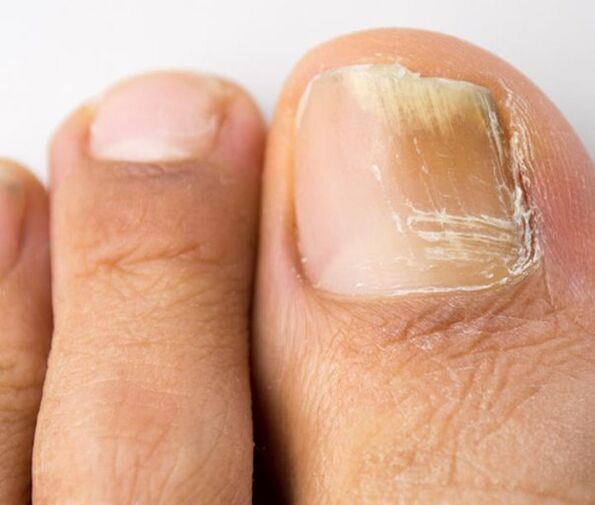
At first, the disease does not manifest itself on the nail plate. It is possible to suspect from separate whitish spots and stripes that there is a nail fungus on the big toe. The photo above shows what the affected area looks like.
In the second stage, the nail fades (sometimes turns yellow), significantly thickens and curves. It can often grow on the skin, causing pain when walking and local inflammation.
In the third stage of onychomycosis, the nail becomes loose, it hurts to cut it. In some patients, the skin may flake off. At this stage, the patient poses a significant threat to others, as their nail plate becomes a receptacle for fungal spores, which are easily dispersed over surfaces.
Classification
Onychomycosis has three stages:
- The first is that there is no change in texture, changes in tone are not visible enough: streaks, spots may appear.
- The second - the plate turns yellow, ceases to shine, an unpleasant smell comes from the feet.
- Third - the plate loses its own texture, becomes loose, exfoliates from the nail bed.
By the color of the nail, you can find out which fungus has occupied it:
- Yellow spots indicate a dermatophyte lesion, while the changes are limited to areas in the center of the plaque and along the edges.
- The location of the changes along the edges and scaling indicate damage by fungi of the yeast family.
- The darkening of the plaque indicates the lack of blood circulation in the finger and the attachment of mold fungi.
Treatment
The success of toenail fungus treatment depends entirely on how early it is started. In the early stages, local remedies can help cure ringworm, and only surgical therapy can help with subsequent stages and an ingrown toenail.
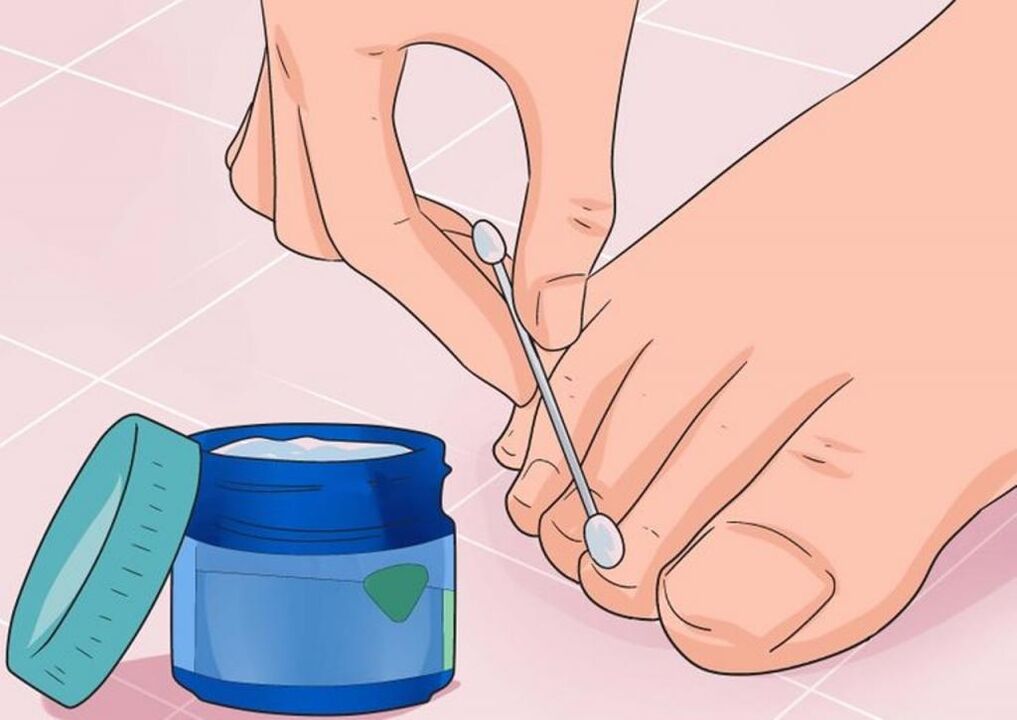
Medicines
Thumbnail fungus is treated with special varnishes, ointments and medications that are taken orally. In the early stages, the disease can be cured in 1-2 months, in later stages it can take six months or even a year.
Lucky you
The action of therapeutic varnishes is associated with a softening of the plaque and a disinfecting result. The varnish penetrates the nail plate and destroys the fungus.
Ointments, creams and sprays
Such drugs are used for dermatomycosis and onychomycosis. They are quite effective and adverse reactions are extremely rare. It is recommended to apply these funds once or twice a day.
oral preparations
Pills for treating big toe fungus are used in later stages. With ringworm, only complex treatment can help. Oral preparations include tablets and capsules.
How to remove a nail
With a fungus on the big toe, removing the nail plate can give an effective result. To do this, use means that help to smooth the nail: stickers, ointments, creams.
hardware pedicure
This is not a cosmetic procedure, but a medical one. Perform it in medical institutions. Hardware pedicure is done with a special nozzle with grinding coating. With the help of this procedure, you can get rid of fungus on the big toe. The photo shows the implementation of a hardware pedicure.
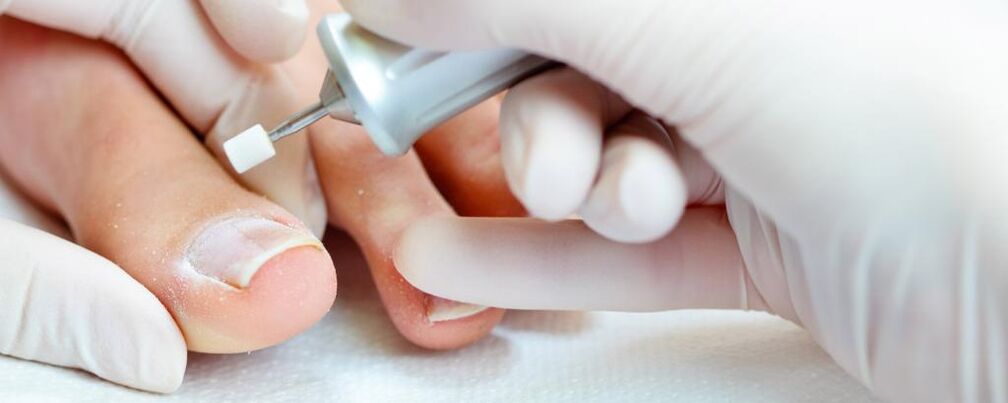
How is the procedure:
- The affected area is disinfected.
- Soften with special medications.
- Remove the outer layer with nozzles.
The procedure is carried out very carefully, gradually removing the layers. If the healthy part of the nail is affected, it can cause the fungus to spread.
The advantages of this method include:
- Quick elimination of the affected parts of the nail.
- Absence of pain.
- Obtaining good permeability for medicinal ointments and varnishes.
But this type of pedicure has disadvantages:
- Allergic reactions may occur.
- There is a risk of infection.
Laser
Laser technologies hold much more promise than other fungal removal methods. The beam heats up punctually and destroys harmful microorganisms without touching healthy tissue.
Removing the nail plates with a laser takes several minutes. If more than one finger is infected, the laser procedure will take longer. To remove a fungus toenail, it may take several sessions, depending on the degree of damage. Healthy nails will only grow back after six months.
Surgery
With this type of procedure, the diseased nail is completely removed. Use this method only in cases where other methods cannot help to get rid of the disease. Removal of the nail from the big toe can destroy the fungus only if, after the operation, the patient undergoes a complex treatment prescribed by the doctor.
The operation is contraindicated:
- People with poor blood clotting.
- Having infectious and other diseases in the acute phase.
- Intolerant to anesthesia.
- Suffering from diabetes.
- Those with immune disorders.
- With dilated veins and permeable capillaries.
How the operation is done
The procedure itself is painless for the patient as it is performed under anesthesia. The nail and surrounding skin are treated with iodine. The doctor inserts a special tool under the nail plate and insulates it from the skin. If a small area of the nail is affected, only that part will be removed.
After the procedure, antibiotic medication is applied to the wound and bandaged. The healing process takes several weeks. Requires ligation. The process of growing a new nail can take several months.
Possible consequences:
- Cut, pain after the procedure.
- Infection.
- Irregular nail growth.
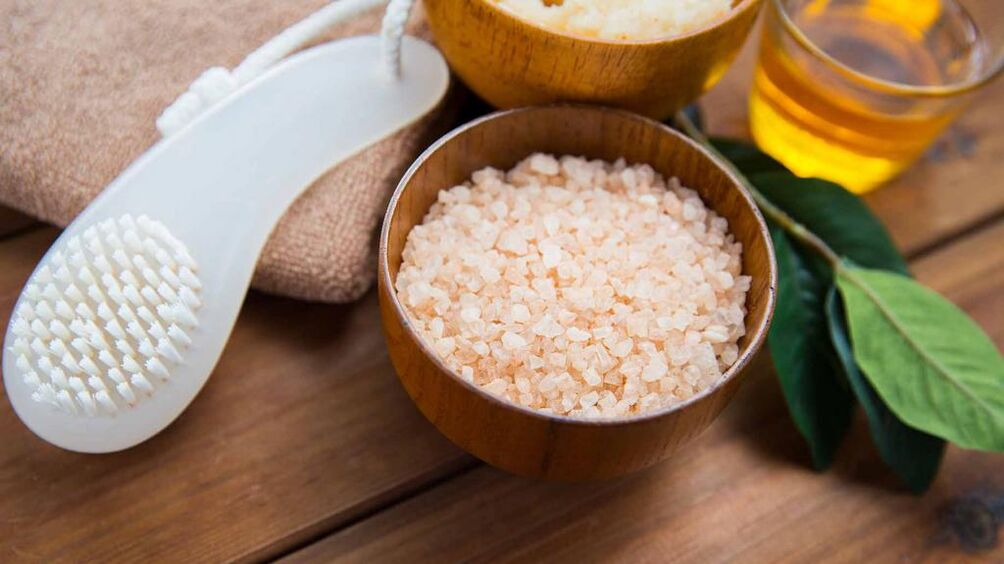
Recovery
Typically, the doctor provides personalized advice on wound care. However, there are some general tips:
- Bed rest after surgery for at least 1 month.
- An open wound should be treated regularly, new sterile dressings applied and medications (ointments, creams) used.
- After the procedure, the doctor prescribes medication (anti-inflammatory, analgesic, antifungal).
Prevention
To reduce the risk of onychomycosis infection, the following recommendations should be followed:
- The fungus can be infected in the beauty salon. This happens in case of insufficient sterilization of manicure-pedicure instruments. You should visit salons that have a good reputation and a large number of positive reviews.
- Accessories for a pedicure performed at home, it is advisable to have your own and not to use strangers.
- If your feet sweat a lot, you should sprinkle them with talcum powder or talcum powder, and also dry them after taking a bath or shower.
- It is recommended to take vitamins that increase immunity.
- Frequent pedicure operations thin the nail plate, break its structure, which contributes to fungal infection.
- Acetone nail polish remover can also damage the nail.
- It is forbidden to wear someone else's shoes.
- The drying towel must be personal.
- Cracked feet are a risky condition for the appearance of mycoses, so they must be treated in a timely manner.
Folk remedies
Those who are interested in how to treat a fungus on the big toe should remember that there are methods of traditional medicine that also show good results.
More often, use these recipes:
- Table vinegar-based lotions. Take half a glass of water, glycerin and vinegar, mix. In the resulting liquid, a gauze napkin is moistened and applied to the nails affected by the fungus for 25 minutes. The procedure should be played 2 times a day.
- Coffee bath. Make the coffee (preferably natural) so that the drink comes out strong and wait for it to cool down a bit. The legs should be lowered into the mixture for 25 minutes. The operation must be performed daily for 5 days.
- Iodine. It is an inexpensive drug, but it is considered a strong antiseptic. They lubricate the affected areas with a cotton swab. It is necessary to carry out the procedure for a week, then take a break of 7 days and start the course again.
- Baths with sea salt. Add a tablespoon of salt to a bowl of warm water and soak your feet in it for 20 minutes.
- Horseradish bandage. It is necessary to take fresh roots of horseradish, grate on a fine grater. For a compress, a teaspoon of grated dough is enough. It is necessary to apply a bandage at night.
- Compress and bath with potatoes. You need potato skins. They need to be washed and boiled, mashed. The broth in which the dressings were cooked should be used for the bath. After that, the prepared puree is applied to the affected nails. Band Aid. When the product cools down, rub the grease inside your nails.
Folk remedies are effective only in the early stages of the disease. They can be used as prophylaxis and in complex therapy.
Assessments
People who suffer from foot fungus write that ointments, varnishes, sprays and any other external agents only help with ringworm at the initial stage. They are not suitable for the treatment of onychomycosis as they are not able to kill all the spores of the fungus. Therefore, during treatment, after a visible improvement, relapses will certainly occur.
Patients are advised not to spare shoes, socks, tights and throw them away during or after therapy.
Also, patients are advised to walk around the house in socks at all times for people who have caught the fungus. Otherwise, the fungus spores will spread throughout the apartment.
According to those who are trying to get rid of nail fungus, this disease is very difficult to treat. The course of therapy should be long. The most effective means for oral use, but they all have many adverse reactions and contraindications.
All patients are unanimous that it is better to follow preventive measures than to treat the disease.
















